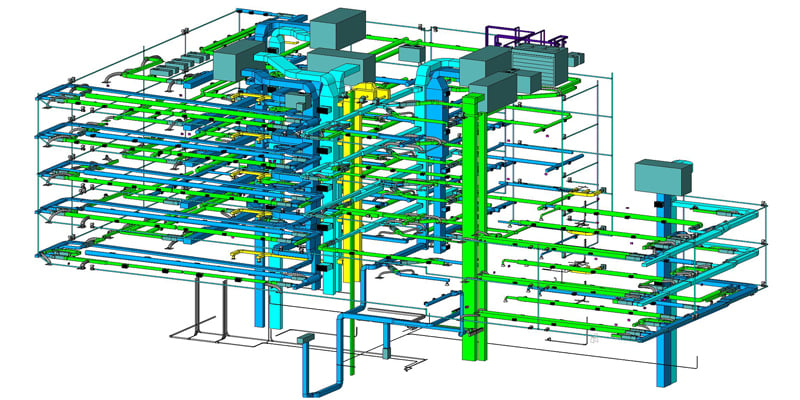
Building Information Modelling (BIM) has transformed the construction industry by streamlining design and construction processes. Specifically, BIM MEP integrates various systems such as heating, ventilation, air conditioning, plumbing, electrical, and more into a single model.
This ensures efficiency, reduces errors, and allows for better collaboration. As industries increasingly recognise the importance of technological integration, BIM MEP is becoming indispensable, not just for construction but for various other sectors like infrastructure and oil & gas.
Why BIM MEP is Gaining Popularity Across Industries
The adoption of BIM MEP is rapidly increasing due to its ability to enhance coordination, improve productivity, and reduce construction costs. In construction, BIM MEP allows for precise MEP design, ensuring that the various systems are integrated seamlessly into the building plan. This integration helps avoid costly delays caused by errors or clashes between systems.
In infrastructure projects, especially in the design of MEP systems, BIM MEP plays a crucial role in simplifying the management of complex systems. The MEP works in construction have benefitted tremendously from this technology, ensuring higher quality and efficiency.
The oil and gas industry, known for its complex projects and the need for accurate MEP engineering, is also increasingly relying on BIM MEP. With BIM MEP services, stakeholders can visualise and optimise the integration of mechanical, electrical, and plumbing systems before the physical construction begins, resulting in cost savings and reduced operational risks.
Global Market Growth of BIM MEP
The global BIM MEP market is experiencing rapid growth. According to recent reports, the market is projected to expand at a compound annual growth rate (CAGR) of over 20% in the coming years. This growth is a result of increasing demand for sustainable building practices, government initiatives promoting smart construction, and the continuous evolution of BIM MEP software.
Currently, regions like North America and Europe are leading in the adoption of BIM MEP, with countries like the United States, the United Kingdom, and Germany spearheading technological advancements. However, Asia-Pacific, particularly countries like China and India, are witnessing a surge in BIM adoption due to urbanisation and infrastructure development.
Also Read: Top 50 MEP Interview Questions & Answers 2025
Key Factors Driving the Global Growth of BIM MEP

Several factors contribute to the rapid growth of BIM MEP worldwide. One of the key drivers is the increasing need for collaboration among various teams involved in construction projects. Traditional methods of managing MEP systems often resulted in errors and delays. However, with BIM MEP, all stakeholders can work together on a single model, ensuring seamless integration of systems and a smoother construction process.
The demand for sustainable buildings is another significant factor. As the world moves towards environmentally friendly construction, BIM MEP allows for efficient energy management by optimising MEP systems for better performance. This ensures that buildings meet strict sustainability standards while reducing energy consumption. BIM MEP simplifies the process by offering a holistic view of the entire project and ensuring that MEP design is flawless, thus reducing errors during construction.
Emerging Technologies Enhancing BIM MEP Capabilities
As technology continues to evolve, BIM MEP is becoming more powerful through the integration of emerging technologies. Artificial intelligence (AI) is being utilised to optimise MEP systems by analysing large data sets to improve performance and predict potential issues before they arise.
The Internet of Things (IoT) is enhancing the capabilities of BIM MEP by allowing real-time monitoring and adjustments of MEP systems in buildings and infrastructure. Another revolutionary technology is the Digital Twin. This technology enables ongoing maintenance, repair, and upgrades to be planned more effectively, ensuring that the MEP works in construction are future-proof.
Future Scope of BIM MEP for Different Industries
The scope of BIM MEP is vast and expanding across multiple industries. In the construction industry, BIM MEP is becoming standard practice, especially for large-scale projects. Its ability to optimise MEP design, reduce errors, and streamline processes is driving its adoption. For the oil and gas industry, where accuracy and efficiency are critical, BIM MEP services are being increasingly relied upon to manage complex MEP systems.
In the infrastructure sector, BIM MEP is vital for managing the complex systems involved in transportation, utilities, and urban planning. Additionally, the rise of smart cities is further increasing the demand for MEP systems integrated with BIM MEP, ensuring sustainability and efficiency.
Also Read: Best Revit MEP Courses in India to Consider in 2025
Growing Demand for BIM MEP Professionals Worldwide
The global adoption of BIM MEP technology is accelerating, leading to a significant increase in demand for professionals skilled in MEP systems and BIM MEP software.
Key Roles and Salary Insights:
1. MEP BIM Engineers
In India, professionals in this role with 2–7 years of experience earn between ₹2.5 LPA and ₹11 LPA, depending on the industry and location.
2. MEP BIM Coordinators
With 4–15 years of experience, salaries range from ₹2.5 LPA to ₹21 LPA, especially in sectors like Engineering & Construction.
3. BIM MEP Modelers
Entry-level positions start at approximately ₹1.5 LPA, with experienced professionals earning up to ₹9.0 LPA in industries such as Engineering & Construction. (AmbitionBox)
4. BIM Managers
Those with 8–12+ years of experience can command salaries ranging from ₹15 LPA to ₹30 LPA, reflecting their strategic role in overseeing BIM projects and teams.
Global Perspective
Internationally, BIM MEP professionals are also witnessing lucrative salary trends:
1. BIM MEP Engineers
In the United States, average annual salaries range from $93,330 to $122,159. (Glassdoor)
2. BIM Consultants
They earn between $87,767 and $112,123 annually with expertise in guiding BIM implementations. (Glassdoor)
Market Growth Insight
The global BIM market, encompassing MEP BIM services, is projected to grow from USD 9.60 billion in 2024 to USD 37.67 billion by 2034, at a CAGR of 16.4%. (Claight)
How Novatr’s BIM MEP Course Prepares Professionals for Global Industry Growth
Here is how Novatr’s course gives you a competitive edge in the global BIM MEP industry:
1. Industry-Curated Curriculum
The course covers everything from core MEP design principles to advanced coordination using leading BIM MEP software, ensuring you're job-ready from day one.
2. Learn from Global Experts
You get mentored by industry professionals working on international projects, offering practical insights into real-world MEP construction workflows and best practices.
3. Hands-On, Project-Based Learning
Build your portfolio by working on simulated projects that mirror actual MEP works in construction, giving you the confidence to handle complex systems and deliverables.
4. Exposure to Cutting-Edge Tech
Stay ahead with training in AI, IoT, and Digital Twins, gaining practical exposure to tools reshaping MEP systems globally.
5. Global Certification & Career Support
Novatr provides internationally recognised certification and dedicated career support, helping you secure high-paying roles as an MEP engineer, BIM Coordinator, or BIM Manager.
Also Read: How Project-Based Learning Helps You Build a Strong Portfolio for MEP Engineers
Conclusion
The future of BIM MEP is undoubtedly bright, with expanding opportunities in construction, infrastructure, oil and gas, and more. As industries continue to realise the advantages of BIM MEP, the demand for skilled professionals will only increase. With the constant technological advancements and the growing need for efficient MEP systems, BIM MEP will continue to shape the future of the built environment.
Novatr’s BIM Professional Program is a standout among MEP-focused BIM courses. For ongoing learning and industry knowledge, check out the Novatr Resource Page.
Was this content helpful to you



.jpeg)

.jpg)
.png)
.png)